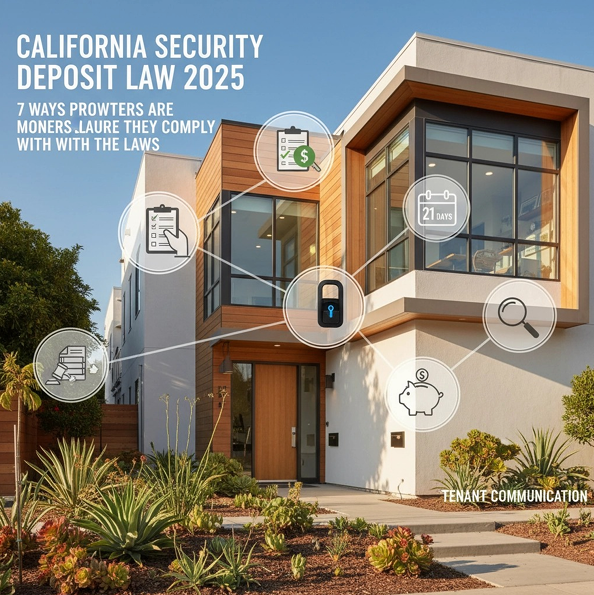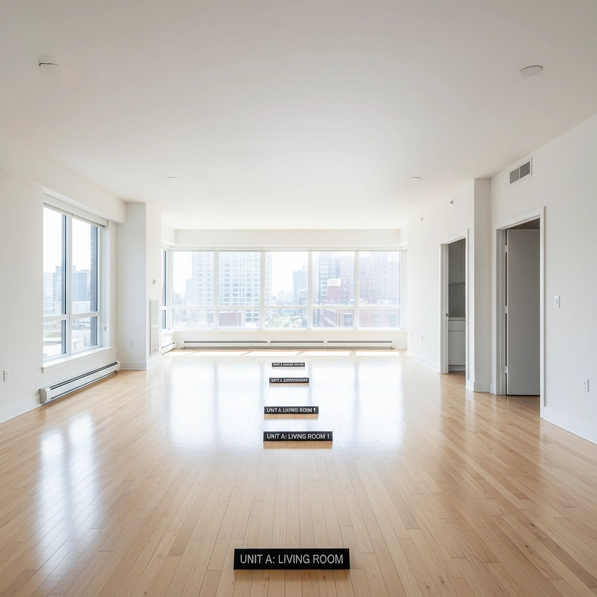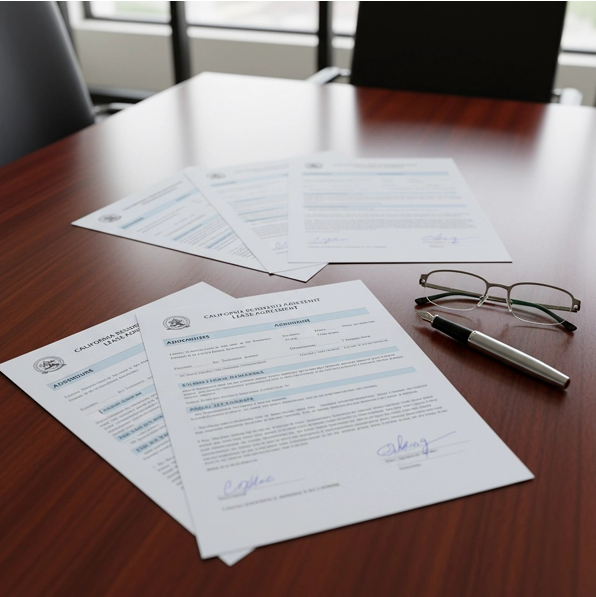California Security Deposit Law 2025: 7 Ways Property Owners Are Making Sure They Comply with the Laws

California's security deposit landscape has undergone a seismic shift in 2025, with Assembly Bills 12 and 2801 fundamentally altering how property owners handle tenant deposits. The confluence of these regulatory changes represents both a challenge and an opportunity for savvy landlords who adapt quickly to the new requirements.
Smart property owners across Los Angeles aren't just scrambling to meet minimum compliance standards: they're implementing systematic approaches that turn these new regulations into competitive advantages. Here's how the most successful property managers are navigating California's evolving security deposit requirements.
1. Implementing Mandatory Photo Documentation Systems
The most significant shift in 2025 centers around AB 2801's photography requirements, which take effect in two critical phases. Beginning April 1, 2025, landlords must photograph units immediately upon receiving possession and before any repairs, then again after completing repairs or cleaning for which they plan to deduct from security deposits.

The July 1, 2025 deadline requires even more comprehensive documentation: photographs must be taken either immediately before or at the inception of every new tenancy. This isn't optional: it's now the foundation of any defensible security deposit deduction claim.
Forward-thinking property owners are investing in professional-grade digital cameras and establishing standardized photography protocols. They're training maintenance staff on proper lighting techniques, angle consistency, and timestamp verification. The
California Department of Real Estate has emphasized that poor-quality photos won't hold up in disputes, making this investment crucial for long-term success.
Property management companies like those offering
comprehensive management services are building photo documentation into their standard operating procedures, ensuring consistent compliance across entire portfolios.
2. Adopting Updated Official Compliance Forms
California's new requirements demand more than just taking pictures: property owners must use updated official forms that include designated spaces for photograph acknowledgment and tenant verification. The revised Move-In Move-Out Inspection Report (Form #272) and Itemization of Security Deposit (Form #610) now include specific areas where landlords indicate the number of photographs included.
These forms require tenants to acknowledge receipt of photos and confirm whether written descriptions match the photographic evidence. This creates a paper trail that significantly strengthens landlords' positions in potential disputes.
Experienced property owners are working with legal counsel to ensure their documentation meets
California Legislative Information standards while streamlining the process for both staff and tenants. The key is making compliance feel routine rather than burdensome.
3. Restructuring Security Deposit Collection Protocols
AB 12's one-month security deposit cap for new tenancies has forced property owners to completely reimagine their risk management strategies. For most residential rental agreements, the maximum security deposit is now limited to one month's rent, representing a significant departure from previous practices.
However, small landlords with specific qualifications can still collect up to two months' rent. Natural persons or LLCs meeting certain criteria who own no more than two residential rental properties with four or fewer total units maintain this higher limit: but documentation requirements are stringent.

Property owners are conducting comprehensive reviews of their portfolios to determine which properties qualify for the higher deposit limits and adjusting lease templates accordingly. This granular approach ensures maximum allowable collection while maintaining full compliance.
The
Los Angeles Housing Department has provided guidance on navigating these distinctions, particularly for owners with mixed portfolio types.
4. Establishing Evidence-Based Deduction Procedures
The new law requires landlords to provide photographs alongside written explanations of costs for any security deposit deductions. This elevates the standard of proof required to justify deductions, transforming what was once a simple itemization into a comprehensive evidence package.
Successful property owners are implementing systematic documentation protocols that begin before tenants even move in. They're creating detailed baseline records that clearly establish the unit's condition, making it easier to demonstrate changes that warrant deductions.
When deductions exceed $125, owners must attach invoices, receipts, or detailed billing information. This requirement is pushing property managers toward relationships with contractors who provide thorough documentation and competitive pricing.
Properties managed through
professional management services often have advantages here, as established companies maintain relationships with vendors who understand documentation requirements.
5. Maximizing Pre-Move-Out Inspection Opportunities
California law requires landlords to notify tenants of their right to request an initial inspection within two weeks before move-out. Smart property owners are turning this tenant right into a strategic advantage by proactively offering these inspections and using them to minimize deposit disputes.
Pre-move-out inspections allow tenants to address issues before they become deductions, reducing both conflict and administrative burden. Property owners are scheduling these inspections systematically, providing detailed written reports that tenants can use to prioritize repairs.

This approach often results in tenants handling minor repairs themselves rather than facing larger deductions. It's a win-win strategy that demonstrates good faith while protecting the property owner's interests.
The
California Courts have noted that landlords who offer thorough pre-move-out inspections typically fare better in disputes, as it demonstrates reasonable cooperation.
6. Streamlining Return Timelines and Itemization Systems
California's 21-day return timeline hasn't changed, but the complexity of required documentation has increased significantly. Property owners are implementing project management approaches to ensure all photographs, receipts, and itemizations are compiled within the legal timeframe.
The most efficient operations use digital workflows that automatically generate itemization letters with photograph attachments. This systematic approach reduces errors while ensuring consistent formatting that meets legal requirements.
Property owners are also establishing clear internal deadlines that provide buffer time before the 21-day limit. This approach accounts for potential delays in contractor invoicing or photograph processing without risking non-compliance penalties.
For properties requiring extensive repairs, owners are prioritizing which work is essential for re-rental versus items that can be addressed later, ensuring deposit returns aren't delayed by non-critical projects.
7. Eliminating Prohibited Payment Fees and Administrative Costs
AB 12 prohibits landlords from charging fees when tenants choose to pay rent or security deposits by check. This seemingly minor provision has required property owners to restructure their payment processing systems and fee structures.
Forward-thinking property owners are viewing this as an opportunity to streamline payment options and reduce administrative complexity. They're eliminating check processing fees while encouraging electronic payments through incentives rather than penalties.
Properties offering
online tenant portals often see higher electronic payment adoption rates, reducing check processing volume naturally.
Some owners are incorporating previously separate fees into base rent calculations, maintaining revenue while complying with the new restrictions. This requires careful lease restructuring and legal review to ensure compliance.
The Competitive Advantage of Proactive Compliance
Property owners who embrace these new requirements systematically are discovering that thorough documentation actually reduces disputes rather than increasing administrative burden. Tenants are more likely to accept deductions when presented with clear photographic evidence and detailed explanations.
HUD resources emphasize that consistent, transparent processes benefit both landlords and tenants by setting clear expectations and reducing misunderstandings.
The key to success lies in treating these requirements as operational improvements rather than regulatory burdens. Properties that implement comprehensive compliance systems often see reduced turnover costs, faster re-rental timelines, and improved tenant relationships.
For property owners seeking
professional guidance on implementing these changes, partnering with experienced management companies can provide the systems and expertise needed to turn compliance into competitive advantage.
California's 2025 security deposit laws represent a new reality for property owners, but those who adapt systematically are discovering that thorough compliance often improves both profitability and tenant relations. The investment in proper systems and documentation pays dividends in reduced disputes, faster turnovers, and enhanced legal protection.
Relevant Resources for California Property Owners
Bookmark these landlord-first resources to navigate California's shifting deposit rules with confidence.
1. Internal Links
2. Authoritative External Resources
- California Department of Real Estate (DRE)
- Los Angeles Housing Department (LAHD)
- California Legislative Information
- U.S. Department of Housing and Urban Development (HUD) - California
- California Courts - Landlord/Tenant Law
3. Local LA Community Links
Share this post
Contact Us



